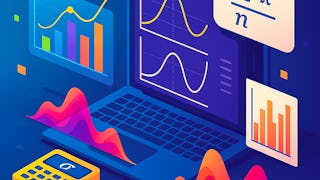Welcome to the Statistical Methods and Data Analysis course! This course serves as an introduction to the statistical and computation methods that have become indispensable tools for those pursuing careers in public policy. Alongside offering the necessary background in basic and applied statistics, the course will also introduce you to the powerful R programming interface.



Ce que vous apprendrez
• Explain the basic statistical reasoning involved in data analysis.
• Explain the applications of data analysis with examples from published research.
• Execute the data analysis projects using R.
Compétences que vous acquerrez
- Catégorie : Sampling (Statistics)
- Catégorie : Statistical Hypothesis Testing
- Catégorie : Statistical Methods
- Catégorie : R Programming
- Catégorie : R (Software)
- Catégorie : Big Data
- Catégorie : Probability Distribution
- Catégorie : Descriptive Statistics
- Catégorie : Statistical Inference
- Catégorie : Regression Analysis
- Catégorie : Decision Tree Learning
- Catégorie : Statistical Modeling
- Catégorie : Probability
- Catégorie : Correlation Analysis
- Catégorie : Statistical Analysis
Détails à connaître

Ajouter à votre profil LinkedIn
septembre 2025
29 devoirs
Découvrez comment les employés des entreprises prestigieuses maîtrisent des compétences recherchées

Il y a 8 modules dans ce cours
Statistical methods, by definition, are tools for identifying patterns in large datasets. This module takes the first step towards statistical analysis by exploring various strategies for visualizing data, an increasingly important skill in today’s era of big data. This module explains the different forms of data, types of plots, and charts used to depict the different forms of data. In addition, the module focuses on different visualization techniques appropriate for big data.
Inclus
10 vidéos3 lectures4 devoirs1 plugin
While data visualization gives us a ‘first cut’ in the empirical world, knowing what the data ‘looks like’ will not take us far towards identifying relationships between variables — the focal point of policymaking. At the minimum, identification requires that the researcher be able to summarize large amounts of information in the form of descriptive statistics. This module explains the measures of central tendency and dispersion for ungrouped data and for grouped data. The measures of central tendency and dispersion for ungrouped data include mean, median, mode, standard deviation, skewness, and kurtosis. The means of central tendency and dispersion for grouped data include grouped mean, grouped standard deviation, grouped mode, and grouped median.
Inclus
8 vidéos1 lecture3 devoirs
Except in the rarest of cases when data on the entire population is available for all attributes of interest to the researcher, social scientists must draw inferences about a population from a sample drawn from that population. This module focuses on the statistical reasoning involved in studying the uncertainty attached to sample statistics. For making inferences about the population from a sample, the module explains the fundamentals of probability theory. In addition, the module explains the concepts of random variables and function of random variables. Finally, the module covers the concepts and applications of the binomial and normal distributions.
Inclus
9 vidéos1 lecture5 devoirs
This module discusses the various strategies available to researchers for drawing samples from a population and the first principles involved in determining sample size. The module explains the sampling strategies for sampling from a population. In addition, the module explains how to measure the accuracy of sample estimates. Finally, the module focuses on statistical inference. The goal of statistical inference is to make a statement about something that is not observed based on something that is observed, within a certain level of uncertainty. The module will discuss the Central Limit Theorem (CLT) and the concept of the confidence interval, which allow us to make such statements.
Inclus
6 vidéos1 lecture4 devoirs
This module introduces the critical distinction between experimental data and observational data. In addition, the module explores statistical inference in the context of experimental data using tests of significance. You will also learn about observational data and the problem of confounding, controlled experiment, and natural experiment. The module focuses on the concepts and methods for analyzing statistical significance, including analytical framework, one sample t-test, two sample t-test, and ANOVA.
Inclus
8 vidéos4 lectures3 devoirs
This module introduces the foundational model for statistical inference with observational data, namely, the ordinary least squares (OLS) regression, paying particular attention to the conditions under which the OLS estimator is the best linear unbiased estimator (BLUE). You will learn about the concept of association, which helps to understand the relationship between two variables. You will also learn about the measures of association appropriate for each variable type: lambda coefficient for nominal variables, gamma coefficient for ordinal variables, and correlation coefficient for interval-ratio variables. Finally, the module focuses on regression analysis by explaining bivariate OLS and multivariate OLS.
Inclus
8 vidéos2 lectures4 devoirs
This module focuses on advanced modeling strategies in settings where the best linear unbiased estimator (BLUE) assumptions are violated. You will learn about how to get valid ordinary least squares (OLS) estimates when one or the other key assumption on regression errors for OLS estimates to be BLUE is violated. In particular, you will learn how to detect and correct OLS estimates for reverse causality, heteroscedasticity, and serial correlation. Next, under violations of BLUE assumptions on model and variable specification, you will learn how to model nominal and ordinal dependent variables.
Inclus
5 vidéos4 lectures3 devoirs
Running regression models on large-scale datasets with millions of observations and thousands of variables can be a daunting task. This module examines the strategies for building regression models when dealing with such datasets. For conducting big data regression analysis with nominal dependent variables, you will learn the concepts of decision tree, pruning, cross-validation, and random forest. You will also learn about the penalized regression approach, which is useful for running big data regressions when the dependent variable is an interval-ratio variable.
Inclus
5 vidéos2 lectures3 devoirs
Préparer un diplôme
Ce site cours fait partie du (des) programme(s) diplômant(s) suivant(s) proposé(s) par O.P. Jindal Global University. Si vous êtes admis et que vous vous inscrivez, les cours que vous avez suivis peuvent compter pour l'apprentissage de votre diplôme et vos progrès peuvent être transférés avec vous.¹
Instructeur

Offert par
En savoir plus sur Data Analysis
 Statut : Essai gratuit
Statut : Essai gratuitUniversity of Colorado Boulder
 Statut : Essai gratuit
Statut : Essai gratuitUniversity of Pittsburgh
 Statut : Essai gratuit
Statut : Essai gratuitMacquarie University
 Statut : Prévisualisation
Statut : PrévisualisationUniversity of Leeds
Pour quelles raisons les étudiants sur Coursera nous choisissent-ils pour leur carrière ?





Ouvrez de nouvelles portes avec Coursera Plus
Accès illimité à 10,000+ cours de niveau international, projets pratiques et programmes de certification prêts à l'emploi - tous inclus dans votre abonnement.
Faites progresser votre carrière avec un diplôme en ligne
Obtenez un diplôme auprès d’universités de renommée mondiale - 100 % en ligne
Rejoignez plus de 3 400 entreprises mondiales qui ont choisi Coursera pour les affaires
Améliorez les compétences de vos employés pour exceller dans l’économie numérique
Foire Aux Questions
To access the course materials, assignments and to earn a Certificate, you will need to purchase the Certificate experience when you enroll in a course. You can try a Free Trial instead, or apply for Financial Aid. The course may offer 'Full Course, No Certificate' instead. This option lets you see all course materials, submit required assessments, and get a final grade. This also means that you will not be able to purchase a Certificate experience.
When you purchase a Certificate you get access to all course materials, including graded assignments. Upon completing the course, your electronic Certificate will be added to your Accomplishments page - from there, you can print your Certificate or add it to your LinkedIn profile.
Yes. In select learning programs, you can apply for financial aid or a scholarship if you can’t afford the enrollment fee. If fin aid or scholarship is available for your learning program selection, you’ll find a link to apply on the description page.
Plus de questions
Aide financière disponible,

